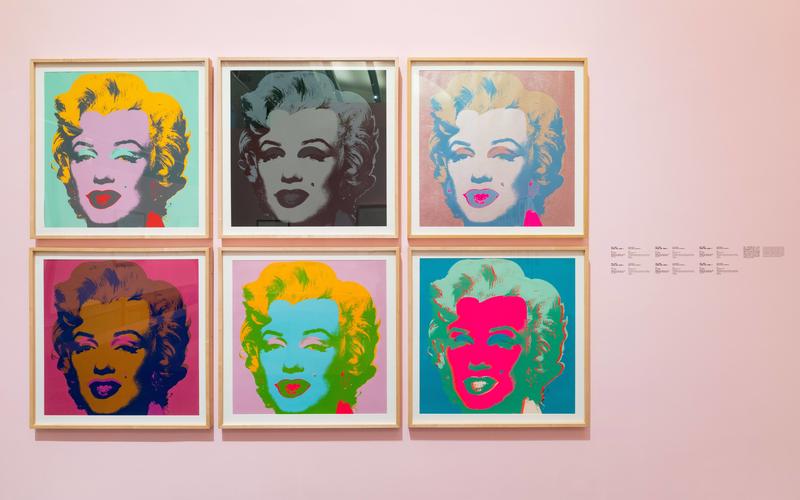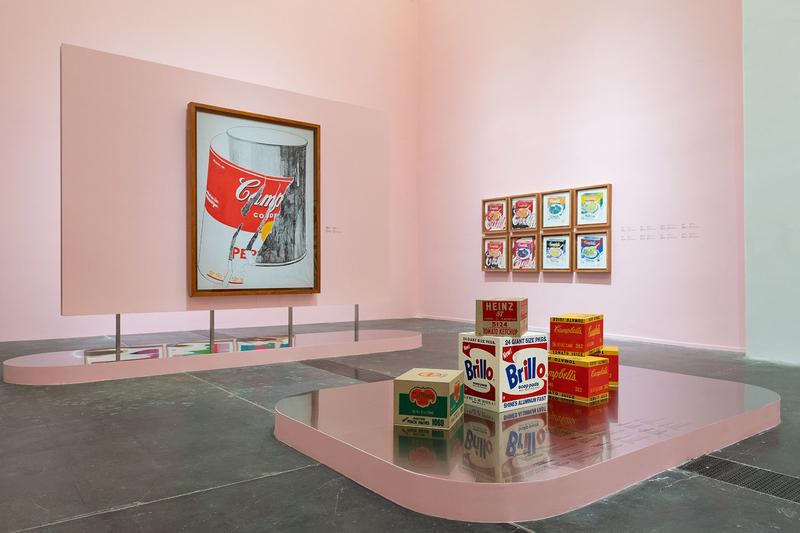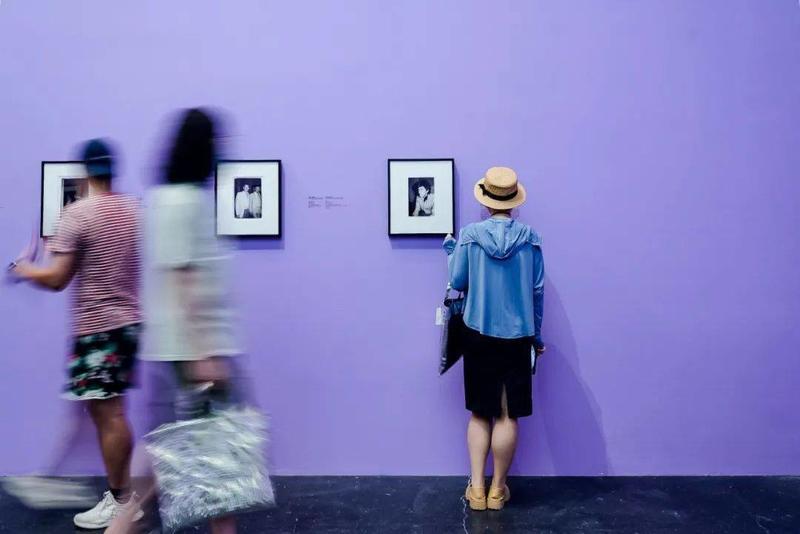An exhibition at UCCA Beijing highlights the versatility of iconic artist Andy Warhol, Lin Qi reports.
 Becoming Andy Warhol, running at the UCCA Center for Contemporary Art in Beijing until Oct 10, navigates Warhol's career spanning four decades, covering various aspects of his life and work through the display of 300 objects. (PHOTO PROVIDED TO CHINA DAILY)
Becoming Andy Warhol, running at the UCCA Center for Contemporary Art in Beijing until Oct 10, navigates Warhol's career spanning four decades, covering various aspects of his life and work through the display of 300 objects. (PHOTO PROVIDED TO CHINA DAILY)
If Andy Warhol were alive today, the pop art icon would have been a social media star. Warhol, a man of curiosity who never limited himself in creativity, knew how to capture the attention of people and how to promote himself.
He blurred the distinctions between fine art and commercial art to make his work, marked with a vibrancy of colors and the appropriation of found, patterned images, reaching a large number of viewers. Considered "a creature of transformation", Warhol constantly explored with different forms of media-photography, film and television-to evoke resonance among people.
Warhol once said: "An artist is somebody who produces things that people don't need to have but that he-for some reason-thinks it would be a good idea to give them."
Warhol is best known for his paintings that depict familiar brands and celebrities, contemplating consumer culture, the role of commercial advertisements and mass media, and the relationship between life and death. The process of evolution from Andrew Warhola (his birth name), son of immigrants who grew up in a working-class neighborhood, to Andy Warhol, the pop art icon, is less known to many.
Becoming Andy Warhol, an ongoing show at the UCCA Center for Contemporary Art in Beijing through Oct 10, has more than 300 works from Warhol's career spanning four decades and covering some other aspects of his life.
The title resonates with Warhol's quote: "If you want to know all about Andy Warhol, just look at the surface of my paintings and films and me, and there I am. There's nothing behind it."
The exhibition adds Warhol to a list of internationally renowned artists whose work UCCA has presented since its founding in 2007, featuring South African contemporary artist William Kentridge, US painter and graphic artist Robert Rauschenberg, US artist Sarah Morris and art icon Pablo Picasso from Spain.
The objects on display are from The Andy Warhol Museum in Pittsburgh, Pennsylvania, where he was born and buried after his death.
 Becoming Andy Warhol, running at the UCCA Center for Contemporary Art in Beijing until Oct 10, navigates Warhol's career spanning four decades, covering various aspects of his life and work through the display of 300 objects. (PHOTO PROVIDED TO CHINA DAILY)
Becoming Andy Warhol, running at the UCCA Center for Contemporary Art in Beijing until Oct 10, navigates Warhol's career spanning four decades, covering various aspects of his life and work through the display of 300 objects. (PHOTO PROVIDED TO CHINA DAILY)
Patrick Moore, director of The Andy Warhol Museum, said in a video speech at the opening on July 3: "We hold the largest collection of Warhol's work and archives in the world, including his film and video work. The museum has a full-fledged educational program, performing arts program, and we also present exhibitions all around the world."
Philip Tinari, director of the UCCA, says the preparations for this exhibition started about two years ago when Picasso-Birth of a Genius was underway at the Beijing venue, and he flew to Pittsburgh to discuss with The Andy Warhol Museum about the possibility of mounting an exhibition.
He says their anticipation initially was not to mount the first Andy Warhol exhibition in China but to present "the best of its kind".
Visitors are able to gain new information about the artist, thanks to intensive research conducted over the years by The Andy Warhol Museum, which introduces itself on its website as "a global destination for scholarship and learning about Warhol's life, art, and relevance to contemporary culture".
In a video speech at the opening, Jose Carlos Diaz, chief curator at The Andy Warhol Museum, described the UCCA exhibition as "a labor of love" for the curatorial team in Pittsburgh.
"It begins with Warhol's origins, childhood and early youth in Pittsburgh. It shows his college work before moving onto his early career in 1950s New York City."
In Warhol's self-portraits, one can see how the artist kept reinventing the physical image of himself. The exhibition offers a rare view of a teenage Warhol. A gouache self-portrait from 1944 is displayed at the entrance of the show along with a photo of the graduation journal of Schenley High School where Warhol studied, with a comment, "As genuine as a fingerprint."
Warhol enrolled into the Carnegie Institute of Technology in 1945. At first, he struggled with the courses, but gradually his innovative style and ideas won recognition among teachers and students.
The exhibition, while introducing Warhol's artistic pursuit in childhood and later in college, also shows the role his mother, Julia Warhola, played. She encouraged him to draw, and she bought him a camera and a film projector, supporting his interest in photography and filmmaking.
Julia Warhola went to live with her son at his New York home in 1952. A self-taught artist, she painted her two favorite subjects, cats and angels, and collaborated with her son on illustrations. Photos of mother and son taken in 1958 are on show in Beijing in juxtaposition with a painting, Cat with "Purr" Inscriptions, which Julia Warhola made between 1957 and 1961, and a drawing jointly by her and her son from 1956.
 Becoming Andy Warhol, running at the UCCA Center for Contemporary Art in Beijing until Oct 10, navigates Warhol's career spanning four decades, covering various aspects of his life and work through the display of 300 objects. (PHOTO PROVIDED TO CHINA DAILY)
Becoming Andy Warhol, running at the UCCA Center for Contemporary Art in Beijing until Oct 10, navigates Warhol's career spanning four decades, covering various aspects of his life and work through the display of 300 objects. (PHOTO PROVIDED TO CHINA DAILY)
Andy Warhol's successful career as an award-winning commercial illustrator in New York during the 1950s is seen through many exhibits.
His signature paintings of some iconic brand advertisements such as those for Coca-Cola in 1961 and Campbell's Soup in 1969 are also on display.
"In it (Coca-Cola, 1961) we see Warhol still painting by hand-he hadn't yet really embraced the silk-screen as he would later on," Moore says. "Warhol still felt himself to be a serious painter. He needed to be able to show us his hand. He needed to give a nod back to abstract expressionism when artists were throwing paint around and there was a lot of vitality."
When people look at Warhol's popular works, they also see him in other ways, such as an experimental photographer and an explorer of abstraction.
The exhibition focuses on his interest in photography, which "hasn't really been explored in a very dense way", Diaz says, adding that people look at Warhol not only as someone "who was using Polaroid cameras to make and produce his portrait commissions" or someone "using appropriated images-photos made by other people", but also as someone "who documented his world-certainly Warhol as the creature of the night-and recorded the life around him".
The exhibition also places a strong emphasis on Warhol as a filmmaker, "something that is sort of underappreciated", says Diaz.
Moore says that when he first arrived at Pittsburgh, he was amazed to find "arguably the most famous Western contemporary artist had an entire body of work (films) that was pretty much unknown or certainly largely unknown".
He adds, "More of the films are being discovered all the time. We are in the process of digitally transferring them."
A few items on show have rarely been exhibited to the public before, including three Polaroid Big Shot cameras, invented in 1971.
"They are chunky and plastic, and they cost about US$20 when they came out. Warhol loved them and used them to do a lot of the celebrity portrait commissions," says Diaz.
A projector from the 1950s and an Oricom camera from 1964 that Warhol used for his feature-length films are also exhibited. Diaz says the Oricom camera is an item being exhibited for the first time outside the Pittsburgh museum.
After Beijing, the exhibition will move on to UCCA Edge, the art institution's Shanghai space.
Contact the writer at linqi@chinadaily.com.cn


